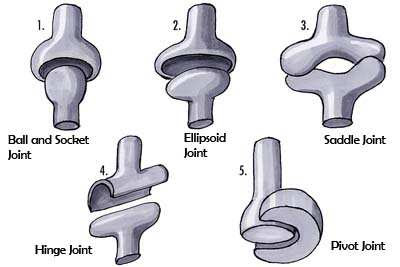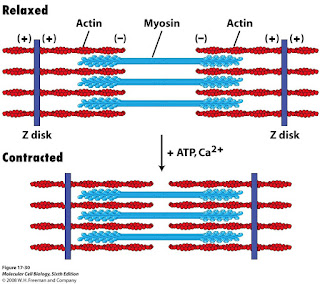For this project, I attempted to redesign the knee joint, which is formed by the femur and patella, in order to prevent runner's knee, or patellofemoral pain syndrome, caused by the wearing down or disalignment of the kneecap. In order for me to know what part of the joint to redesign, I started the project off with perusing the internet for information about how and why runner's knee occurs. Once I found sufficient information, I brainstormed ways to protect the kneecap or keep it in place so that pain can be reduced or prevented.
The joint I am redesigning is the patella, which lies between the femur bone and the tibia. The bottom of the patella is attached to the tibia (shinbone) by the patellar tendon (which is actually a ligament) and to the quadriceps by the quadriceps tendon from the top (
"Patellar Tendon Tear"). The quadriceps and tendons work together to straighten the knee as well as support any other movements made by the leg. One of the common reasons why runner's knee occurs is because the muscles around it are not strong enough to support the kneecap. Quadriceps and hamstrings are important for lessening the pressure on the knee and for keeping the kneecap in place (
"Runner's Knee"). There is a specific groove on the femur where the kneecap is supposed to slide, so as you can imagine, if the knee cap moves out of alignment, both the cartilage on the femur and tibia can be damaged by the rubbing together of bones (
"Patella"). Patellofemoral pain syndrome occurs when the patella rubs on the femur underneath it and leads to other problems. When the cartilage wears out, the shock absorption abilities of the knee decreases, furthering the degradation of the patella and surrounding bones (
"Runner's Knee"). However, the damage done to the cartilage on the femur is not what actually causes pain--there are no nerves or blood vessels being damaged there. What causes the pain is what follows as a result of damaged cartilage or excessive stress on the knee the bone underneath and surrounding soft tissue can be damaged (
"Patellofemoral Pain Syndrome").
The reason this syndrome is nicknamed runner's knee is because the repetitive running motion naturally causes the motions that the condition often stems from: more friction in the knee area, tightening of hamstring and calf muscles, disalignment of kneecap, ect. Of course non-runners can feel the symptoms of patellofemoral pain syndrome too if they lack proper exercise or suffer from biomechanical problems of their bones, so everyone should be aware of this problem.
 |
brown-bone, tan-cartilage/tendons,
blue-bursae, red-muscle |
 |
increased cartilage, increased bursae size,
modified femoral groove not shown |
If the joint could be redesigned, to keep the kneecap in track, I would deepen the femoral groove so that there would be less wriggle room and perhaps increase the synovial fluid around the knee to reduce friction and rubbing together of bones. The size of the bursae can't increase too much though because inflammation of the synovial membrane causes another problem, synovitis, that is also painful (
Biel). I would also make the cartilage on the femur and patella thicker and cover a larger area so that there is more cartilage to go through and more shock could be absorbed.
I came up with this design after contemplating how to prevent the patella from dislocating and how to lessen the inevitable wear-and-tear of bones. Since, to some degree, bones cannot be entirely protected from wearing down, the best solution would be to make the joint slide as smoothly as possible to make the bones last as long as possible, hence increasing the amount of lubrication. Increasing the size of the bursae that holds synovial fluid helps with this. Increasing the thickness of cartilage also helps prolong the life of the bone by giving more cushion before the patella impacts the femur underneath it. The added coverage of cartilage decreases the chance that the patella will rub on the femur as well because if the patella is dislocated, at least the dislocation may still place the kneecap on the part of the femur that has cartilage.
However, the anatomy of the bone is the way it is now because evolution has found that it works, so it would be no surprise if my redesign of the joint ran into some problems. As I mentioned before, the inflammation of the synovial membrane causes a painful condition called synovitis (
Biel). I would expect increasing bursae size to increase lubrication would create similar effects as the inflammation of synovial membrane might. In addition, extra cartilage thickness might result in too much cushion and make the knee less stable because cartilage is softer and squishier than the spongy bone or compact bone that lies underneath.
To prevent runner's knee realistically with what we have now, strengthening and stretching the hamstring, calf, and quadriceps muscles will help provide needed support to the patella. If you already have runner's knee, it is important to avoid downhill slopes and other knee bending activities to alleviate stress until the knee is properly healed (
"Runner's Knee").
This assignment was pretty cool because it really brought together all the information we've been learning for the past month about joints, bones, and muscles. We were also forced to think beyond just facts in order to redesign the joint and use information to work with our creativity, so I thought this project was a nice close to this unit.
Works Cited
Biel, Andrew. Trail Guide to the Body: How to Locate Muscles, Bones and More. Boulder, Colo: of Discovery, 2008. Print.
"Patella." Healthline. Ed. Healthline Medical Team. Healthline Media, 07 Apr. 2015. Web. 07 May 2017.
"Patellar Tendon Tear." OrthoInfo. American Academy of Orthopaedic Surgeons, 01 Feb. 2016. Web. 07 May 2017.
"Patellofemoral Pain Syndrome." Sports Injury Clinic. Virtual Sports Injury Clinic, n.d. Web. 07 May 2017.
"Runner's Knee." Runner's World. Runner's World, n.d. Web. 07 May 2017.



